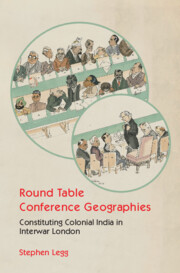Book contents
- Frontmatter
- Contents
- List of Figures and Tables
- Acknowledgements
- Note on Conversions, Spellings and Abbreviations
- 1 Introduction: Squaring Round Tables
- Part I Geographical Imaginations
- Part II Conference Infrastructures
- Part III The Conference City
- Part IV Representations
- Notes
- References
- Index
- Miscellaneous Endmatter
2 - Dominion and Dyarchy: The Absent Presences
Published online by Cambridge University Press: 15 January 2023
- Frontmatter
- Contents
- List of Figures and Tables
- Acknowledgements
- Note on Conversions, Spellings and Abbreviations
- 1 Introduction: Squaring Round Tables
- Part I Geographical Imaginations
- Part II Conference Infrastructures
- Part III The Conference City
- Part IV Representations
- Notes
- References
- Index
- Miscellaneous Endmatter
Summary
The First World War not only reconfigured the British Empire’s economy, politics and demographics, but it also disrupted its sense of time and space. Imperial weldings of history and geography had previously placed Europe in a present-future to which the rest of the past-present world might aspire (Fabian 1983). This aspiration was viewed sequentially, with peoples and nations passing through a series of stages in order to reach a (permanently deferred) shared status of modernity and democracy (Kaviraj 2005). During and after the war this geography was challenged by people of the empire who looked across its global scope and wanted what other (whiter, richer, more independent) people had, immediately (Matera and Kent 2017).
The result was an attempt to configure a ‘third’ British Empire. The first such empire had been focused on settler colonies in the western hemisphere with a pretence at cultural unity (Darwin 1999). The second, post–American Revolution empire encompassed societies in Africa and Asia that required local collaborators and a geographical differentiation between the informal empire, settler colonies and a ‘dependent’ empire that included India. The turbulent decade after the war saw radical change produce a third empire, with new mandated territories in the Middle East, democratic reforms in the United Kingdom and British India, and the formalisation of the older white settler colonies of Canada, New Zealand, Australia and South Africa, as well as the Irish Free State, into dominions. The latter would be the cornerstones of the development of the modern commonwealth, after the jettisoning of imperial federationist attempts to unify the empire at the Imperial Conference of 1917 (Darwin 1999, 68).
Mrinalini Sinha (2013, 171) has shown that the Commonwealth envisaged the empire configured like the League of Nations, as a hierarchy of current or potential nation-states. Her reading retains an emphasis on the dominions, but as drivers of imperial reform, not merely as models for the Commonwealth. The third empire hierarchy was racial, with white-dominated dominions and the British government propagating inequality between the Crown’s colonial subjects in terms of mobility, law and institutional recognition (Banerjee 2010; Mawani 2018). It was this geographical imagination of a nation-state empire rather than an imperial empire that marked out the interwar world and informed both colonial and anti-colonial projects (Sinha 2013).
- Type
- Chapter
- Information
- Round Table Conference GeographiesConstituting Colonial India in Interwar London, pp. 37 - 64Publisher: Cambridge University PressPrint publication year: 2023



